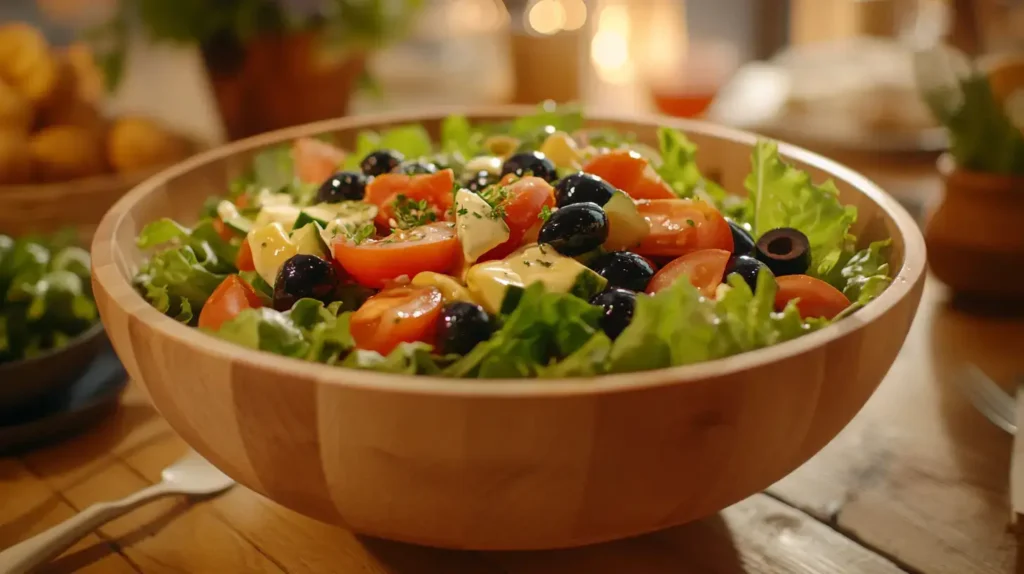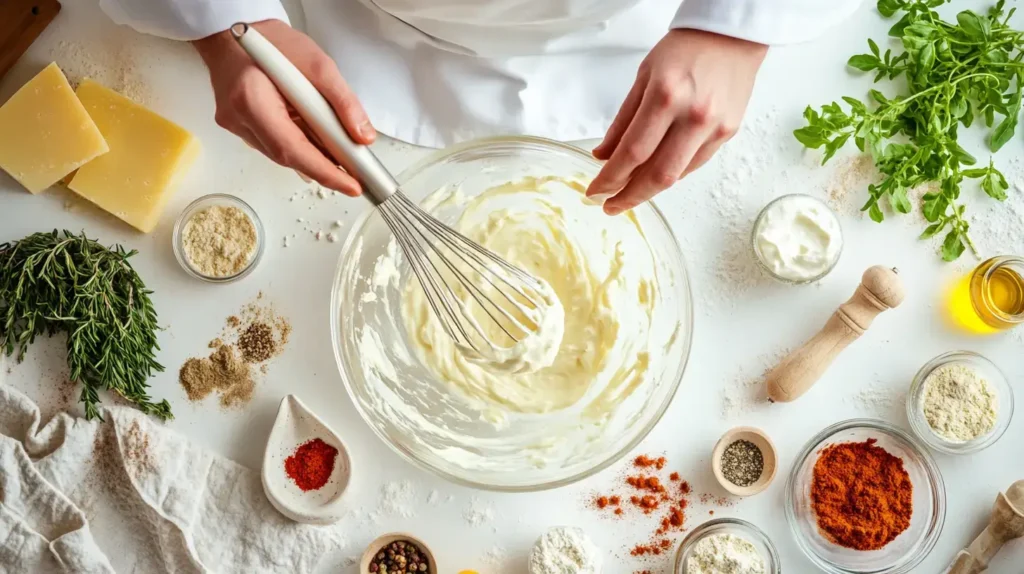There’s just something magical about that Olive Garden salad dressing. You know the one—zesty, creamy, and a little tangy, poured all over those crunchy greens at your favorite Italian-American restaurant. But guess what? You don’t have to wait for your next dine-in meal to enjoy it.
This article covers everything you need to know about this delicious dressing, from what’s in it and how to make it at home, to fun ways to use it beyond salad. Whether you’re a fan of the copycat Olive Garden dressing, curious about healthier versions, or just want to know where to buy it, you’re in for a flavorful ride.
Chef Mia, a family-style cooking expert, says:
“When I first recreated Olive Garden’s salad dressing for a dinner party, I couldn’t believe how quickly it disappeared! My guests were dipping bread, veggies—even grilled chicken. That’s when I knew this recipe was more than just a salad topper—it’s a kitchen MVP!”
What Is Olive Garden Salad Dressing?
What Makes It So Popular?
The popularity of Olive Garden salad dressing isn’t just about the brand—it’s about how it tastes. The moment it hits your taste buds, you get a perfect mix of:
- Tangy vinegar
- Creamy texture
- Herby Italian flavor
- Just a touch of sweetness
Unlike other store-bought dressings that can taste flat or overly oily, this one has a balanced zing that livens up any meal. It’s not too thick, not too thin—just right for tossing or dipping.
“It has a nostalgic taste. It reminds people of dining out with family, endless salad bowls, and warm breadsticks,” says a food blogger from TasteWeekly.
People also love how it:
- Works on more than just salads
- Pairs well with both fresh veggies and cooked foods
- Is easy to make at home
History of the Famous Dressing
The story of Olive Garden’s famous salad dressing starts in the 1980s when the restaurant chain launched its signature salad and breadstick combo. It wasn’t long before people fell in love with the Italian dressing that came with it.
Originally, the dressing was only available in restaurants. But as demand grew, Olive Garden partnered with manufacturers to bring that bottled goodness to store shelves.
“We had customers begging for it. Literally writing letters and calling our offices,” recalls an ex-employee in a behind-the-scenes food podcast.
Now, it’s a pantry staple in many homes—used not just for salads but for pasta salads, marinades, and party dips, too.
Bonus: Nutrition Facts Table
Here’s a quick look at what’s inside a 2-tablespoon serving of Olive Garden Salad Dressing (bottled version):
| Nutrient | Amount |
|---|---|
| Calories | 80 kcal |
| Total Fat | 8g |
| Saturated Fat | 1g |
| Sodium | 520mg |
| Carbohydrates | 2g |
| Sugar | 1g |
| Protein | 0g |
| Gluten-Free | Yes |

What’s in Olive Garden Salad Dressing?
Common Ingredients
If you’ve ever looked at the back of a bottle of Olive Garden Salad Dressing, you might have noticed a list that seems long and a little scientific. However, once you break it down, the core ingredients are surprisingly simple.
Here’s what typically goes into the mix:
- Water
- Soybean oil
- Vinegar (white or distilled)
- Egg yolks
- Romano cheese
- Garlic and onion powder
- Sugar
- Salt and spices
- Xanthan gum (a thickener)
In addition, store-bought versions may contain preservatives and stabilizers to extend shelf life and keep everything smooth and creamy.
“I love how the dressing balances creaminess with just the right amount of tang,” says Chef Lila, a salad-lover and cookbook author. “It gives plain greens a real personality.”
Though it has a base similar to traditional Italian dressing, the Olive Garden version stands out thanks to its cheesy, zesty twist. As a result, it has become a favorite not only for salads but for many other dishes.
Comparing Store-Bought vs. Homemade
Let’s be honest—there’s something convenient about grabbing a bottle of Olive Garden Salad Dressing off the grocery store shelf. But is it the best option?
Here’s a quick comparison:
| Feature | Store-Bought | Homemade |
|---|---|---|
| Flavor | Consistent, a bit processed | Fresh, bright, customizable |
| Shelf Life | 3–6 months (unopened) | 5–10 days (refrigerated) |
| Ingredients Control | Limited (additives, preservatives) | Full control over all ingredients |
| Cost per Serving | Lower (per ounce, when bought in bulk) | Varies, but often cheaper if made in bulk |
| Customizable? | ❌ Not really | ✅ Absolutely! Adjust to taste and diet |
Therefore, if you’re looking for convenience and long shelf life, the store-bought version works well. However, if you care about taste and fresh ingredients, the homemade version is a no-brainer.
➡️ For a full homemade breakdown, check out this Olive Garden Salad Dressing Recipe on Collective Recipes—it’s creamy, zesty, and only takes 10 minutes!
How to Make Olive Garden Salad Dressing at Home
Classic Copycat Recipe
Ready to make your own version at home? It’s easier than you might think—and, best of all, you probably already have most of the ingredients in your pantry.
Here’s a simple copycat Olive Garden dressing recipe:
| Ingredient | Amount |
|---|---|
| Mayonnaise | ½ cup |
| White vinegar | ⅓ cup |
| Olive oil | ¼ cup |
| Water | ¼ cup |
| Grated Romano cheese | 2 tablespoons |
| Garlic powder | ½ teaspoon |
| Italian seasoning | 1 teaspoon |
| Sugar | 1 teaspoon |
| Salt | ¼ teaspoon |
| Lemon juice (fresh) | 1 tablespoon |
Instructions:
- Whisk all ingredients together in a medium bowl until fully blended.
- Taste and adjust seasoning, especially the vinegar or sugar.
- Store in a sealed jar and refrigerate for 1 hour before serving.
“Homemade always wins. In fact, the flavor is sharper, the texture richer, and it’s done in under 15 minutes!” — Home chef Mark S.
👉 Looking for a detailed version? Check out our full Olive Garden Salad Dressing Recipe for extra tips and variations.
This dressing goes well with simple salads. Moreover, it’s also amazing as a drizzle for grilled chicken or even pasta.
Healthier Homemade Versions
Sometimes we love dressing a little too much, don’t we? If that’s the case, and you’re watching your sugar, sodium, or fat intake, no worries—there are several easy tweaks you can make.
Try these healthier alternatives:
- Use Greek yogurt instead of mayo for more protein and less fat.
- Swap olive oil with avocado oil for heart-healthy fats.
- Go light on sugar or skip it entirely.
- Choose low-fat cheese or skip cheese altogether if needed.
On the other hand, don’t skimp on spices—they’re the soul of the flavor!
These substitutions still give you that creamy, zesty feel without making your salad a calorie bomb. Thus, you get the best of both worlds: bold flavor and better nutrition.
Here’s a simple copycat Olive Garden Salad Dressing recipe that you can also find on our website.

Best Ways to Use Olive Garden Salad Dressing
Not Just for Salads
You might think Olive Garden Salad Dressing is just for leafy greens. However, it’s far more versatile than that. In fact, many home cooks use it as a secret weapon to boost flavor in unexpected dishes.
Here are some creative ways to enjoy it:
- Pasta Salad: Toss it with cooked rotini, cherry tomatoes, mozzarella cubes, and black olives.
- Wraps & Sandwiches: Use it as a spread or drizzle for Italian subs or grilled chicken wraps.
- Veggie Dips: It makes a tangy dip for baby carrots, bell pepper strips, and celery.
- Roasted Vegetables: Drizzle a little over steamed or oven-roasted broccoli for a flavor punch.
- Crackers & Cheese Boards: Add a small bowl of dressing to your charcuterie spread for a surprising dip.
In addition, it works wonderfully as a zesty ingredient in party appetizers. Think pinwheel roll-ups or cold pasta skewers—it adds a pop of flavor with no extra work.
“I used it once on leftover rotisserie chicken, and now I never go without it in the fridge,” said one reader. “It’s way more than a salad dressing!”
It also pairs perfectly with chilled pasta meals like this tasty Chicken Pasta Salad Recipe.
Creative Serving Ideas
If you’re hosting a potluck or dinner party, Olive Garden Salad Dressing can help you elevate the menu without much extra effort. Plus, it’s a budget-friendly ingredient that stretches across multiple dishes.
Try these ideas:
- Mini Salad Cups: Serve lettuce, tomatoes, olives, and cheese in small plastic cups with a drizzle of dressing. No forks needed!
- Bruschetta with a Twist: Mix the dressing with diced tomatoes and top on toasted bread slices.
- Marinated Grilled Chicken: Use it as a quick marinade before tossing chicken breasts on the grill.
- It also pairs perfectly with chilled pasta meals like our popular Chicken Pasta Salad Recipe.
Nutrition and Health Tips
Is Olive Garden Salad Dressing Healthy?
Here’s the thing—while Olive Garden Salad Dressing is super tasty, it’s not exactly a “light” food. But, that doesn’t mean it’s off-limits if you’re trying to eat smart.
Let’s break it down. In a typical 2-tablespoon serving of the store-bought version, you’ll find:
| Nutrition Facts | Amount |
|---|---|
| Calories | 80 kcal |
| Total Fat | 8g |
| Saturated Fat | 1g |
| Sodium | 520mg |
| Sugar | 1g |
| Protein | 0g |
| Carbs | 2g |
Therefore, it’s best to enjoy it in moderation—especially if you’re watching sodium or fat. Nonetheless, pairing it with veggie-rich dishes can help balance your meal.
How to Make It Healthier
Thankfully, it’s easy to tweak your homemade version for a healthier bite. Try these smart swaps:
- Greek yogurt instead of mayonnaise
- Less oil and more vinegar or lemon juice
- Use honey instead of sugar (or skip sweeteners altogether)
- Light cheese like Parmesan or skip cheese for a dairy-free twist
On the other hand, don’t give up flavor just to cut calories. Spices like garlic powder, oregano, or even red pepper flakes add zing without adding fat or sugar.
If you’re seeking a balanced approach, go half-and-half—use both mayo and yogurt. That way, you get creaminess with less guilt.

Where to Buy Olive Garden Salad Dressing
Grocery Store Locations
If you’re craving that creamy Olive Garden Salad Dressing flavor at home, you’re in luck. You don’t need to head to the restaurant or make it from scratch every time. In fact, you can find the bottled version in many regular grocery stores.
Here’s where to look:
- Walmart
- Kroger
- Safeway
- Target
- Publix
- Albertsons
- Meijer
In addition, some smaller local supermarkets also carry it, usually in the condiment or salad dressing aisle.
Tip: Look for the signature green label on the bottle. That’s how you’ll know it’s the real deal!
However, keep in mind that availability might vary depending on your location or season. If it’s not on the shelf, don’t worry—there’s always the online option.
Online Shopping Options
Sometimes, your local store doesn’t have what you need. Luckily, you can find Olive Garden Salad Dressing online with just a few clicks.
Popular online options include:
- Amazon – Available in packs of 1, 2, or more
- Walmart.com – Great for store pickup or home delivery
- Olive Garden’s Official Website – Buy direct from the source
Therefore, if you want to stock up or send a bottle to a friend, ordering online is fast and easy. Moreover, you might even find limited-edition versions or combo packs that aren’t sold in stores.
Customer Favorites and Reviews
What People Love About It
Ask almost anyone who’s tried it, and they’ll tell you—the flavor of Olive Garden Salad Dressing is unforgettable. In fact, some fans even say it’s their favorite part of the restaurant meal.
Here’s what makes it a hit:
- That zesty tang and creamy texture
- How it pairs well with fresh greens, pasta, and even meats
- The convenience of having restaurant-quality dressing at home
Moreover, many people enjoy using it in recipes beyond salads, which makes the bottle go a long way.
“I use it on sandwiches, salads, and even as a dip for chicken tenders,” one fan wrote. “It’s a must-have in my fridge.”
Fans of sweet-and-savory blends will also love our Strawberry Spinach Salad — another dressing favorite on the site.
Criticisms or Warnings
Even with lots of love, Olive Garden Salad Dressing isn’t perfect for everyone. For example, some customers say the bottled version tastes slightly different from what they get in the restaurant.
On the other hand, this might be due to how fresh ingredients taste when made in bulk for shelves.
A few things people mention:
- A bit too salty or tangy for some
- Needs shaking before each use
- Shorter shelf life after opening (about 30 days)
Thus, it’s best to check the label, use it within the recommended time, and store it properly in the fridge.
Fans of sweet-and-savory blends will also love our refreshing Strawberry Spinach Salad with Poppyseed Dressing.
Storage, Shelf Life & Food Safety
Storing Homemade Dressing
If you’re making your own Olive Garden Salad Dressing at home, storage matters. After all, fresh ingredients like mayo, cheese, and vinegar need the right care to stay safe and tasty.
So, how should you store it?
- Pour the dressing into a clean glass jar or bottle with a tight lid.
- Keep it in the fridge at all times.
- Label it with the date you made it.
Generally, homemade dressing lasts for about 7 to 10 days in the fridge. However, if it starts to smell odd or look separated, it’s better to toss it.
Pro Tip: Always use a clean spoon when scooping dressing. That way, you avoid adding bacteria that can spoil it faster.
Storing Bottled Versions
Bottled Olive Garden Salad Dressing is made to last longer, but it still needs a little care.
- Store unopened bottles in a cool, dry place, like a pantry.
- Once opened, refrigerate it immediately.
- Shake well before each use.
Most importantly, check the expiration date on the bottle. Usually, you should use it within 30 days after opening for best flavor and safety.
Therefore, while bottled dressing gives you more time, always read the label and follow instructions. In addition, don’t forget to keep the cap tightly closed.
FAQs – People Also Ask
1. What is Olive Garden salad dressing made of?
Olive Garden Salad Dressing is made with a mix of vinegar, oil, egg yolks, Romano cheese, and Italian spices. In fact, it tastes like zesty Italian dressing with a creamy twist. This unique blend is what gives the dressing its famous flavor.
2. Can I buy Olive Garden salad dressing in stores?
Yes! You can find it at most big grocery stores like Walmart, Kroger, and Target. If it’s not there, you can also buy it online from Amazon or Olive Garden’s own website. So, getting your favorite dressing is easier than ever.
3. Is Olive Garden salad dressing gluten-free?
According to the label, the bottled version is gluten-free. However, if you have strong gluten sensitivity or celiac disease, it’s still wise to double-check ingredients or contact the company.
4. How long does Olive Garden salad dressing last?
- Bottled: Up to 6 months unopened
- Opened: About 30 days in the fridge
- Homemade: 7–10 days refrigerated
Thus, always check dates and keep it cold to stay safe.

Conclusion
So there you have it—Olive Garden Salad Dressing isn’t just a restaurant favorite, it’s a go-to for home kitchens too. Whether you buy it at the store or whip it up yourself, its bold and creamy flavor makes meals more fun.
Moreover, it’s flexible. You can drizzle it over salads, dip veggies, marinate meats, or even use it in pasta salad. On the other hand, just remember to store it right and enjoy it within a safe time frame.
In short, it’s more than a dressing. It’s a flavor upgrade for almost anything on your plate.
It’s more than a dressing. It’s a flavor upgrade for almost anything on your plate. Want to make it now? Try our full Olive Garden Salad Dressing Recipe.
